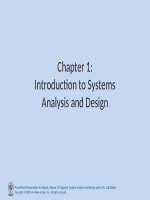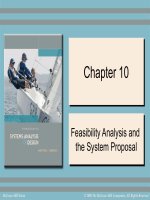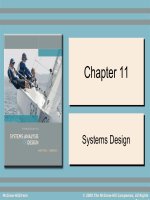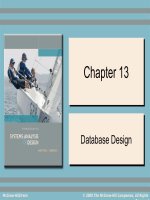Lecture Introduction to systems analysis and design Chapter 17 Whitten, Bentley
Bạn đang xem bản rút gọn của tài liệu. Xem và tải ngay bản đầy đủ của tài liệu tại đây (1.02 MB, 31 trang )
Chapter
Chapter 17
17
Object-Oriented
Object-Oriented
Design
Design and
and Modeling
Modeling
Using
Using the
the UML
UML
McGraw-Hill/Irwin
© 2008 The McGraw-Hill Companies, All Rights
Objectives
• Understand entity, interface, control, persistence, and system
classes.
• Understand the concepts of dependency and navigability.
• Define visibility and explain its three levels.
• Understand the concept object responsibility and how it is
related to message sending between object types.
• Describe the activities involved in object-oriented design.
• Differentiate between a design use-case narrative and an
analysis use-case narrative.
• Describe CRC card modeling.
• Model class interactions with sequence diagrams.
• Construct a class diagram that reflects design specifics.
• Model object states with state machine diagrams.
17-2
Object-Oriented Design
Object-oriented design (OOD) – an
approach used to specify the software
solution in terms of collaborating objects,
their attributes, and their methods.
– Continuation of object-oriented analysis
17-3
Design Classes
In OO programming
every piece of code
resides inside an
object class
17-4
Types of Design Classes
Entity Class - contains business related
information and implements analysis classes.
Interface Class - provides the means by which
an actor interacts with the system.
– A window, dialogue box, or screen.
– For nonhuman actors, an application program interface (API).
Control Class - contains application logic.
Persistence Class - provides functionality to
read and write to a database.
17-5
System Class - handles operating systemspecific functionality.
Design Relationships Dependency
• A dependency relationship is used to model the
association between two classes:
– To indicate that when a change occurs in one class,
it may affect the other class.
– To indicate the association between a persistent
class and a transient class.
• Interface classes typically are transient
– Illustrated with a dashed arrow
17-6
Design Relationships Navigability
• Classes with associations can navigate (send
messages) to each other.
• By default the associations are bidirectional.
• Sometimes you want to limit the message sending to
only one direction.
• Illustrated with an arrow pointing in the direction a
message can be sent.
17-7
Attribute and Method Visibility
Visibility – the level of access an external object
has to an attribute or method.
– Public attributes/methods can be accessed/invoked
by any other method in any other object or class.
Denoted by the + symbol
– Protected attributes/methods can be accessed/
invoked by any method in the same class or in
subclasses of that class. Denoted by the # symbol
– Private attributes/methods can be accessed/invoked
by any method in the same class. Denoted by the –
symbol
17-8
Method – the software logic that
is executed in response to a message.
Object Responsibilities
Object responsibility – the obligation
that an object has to provide a service
when requested and thus collaborate with
other objects to satisfy the request if
required.
– An object responsibility is implemented by
the creation of methods that may have to
collaborate with other objects and
methods.
17-9
Object Responsibility
17-10
The Process of Object-Oriented
Design
• Refining the use case model to reflect
the implementation environment.
• Modeling class interactions, behaviors,
and states that support the use case
scenario.
• Updating the class diagram to reflect
the implementation environment.
17-11
Refining The Use Case Model
• Step 1: Transform the “Analysis” Use
Cases to “Design” Use Cases
– Implementation details
– Controls
– Window/web page names
– Navigation instructions
• Step 2: Update the Use Case Model
Diagram and Other Documentation to
Reflect any New Use Cases
17-12
Design Use Case
17-13
Modeling Class Interactions,
Behaviors, and States
• Step 1: Identify and Classify Use-Case
Design Classes
• Step 2: Identify Class Attributes
• Step 3: Identify Class Behaviors and
Responsibilities
• Step 4: Model Object States
• Step 5: Model Detailed Object
Interactions
17-14
Step 1: Identify and Classify
Use-Case Design Classes
Interface, Control, and Entity Classes of Place New Order Use Case
Interface Classes
W00-Member Home Page
W02-Member Profile Display
W03-Display Order Summary
W04-Display Order
Confirmation
W09-Member Account Status
Display
W11-Catalog Display
W15-Product Detail Display
17-15
Controller Classes
Place New Order Handler
Entity Classes
Billing Address
Shipping Address
Email Address
Active Member
Member Order
Member Ordered Product
Product
Title
Audio Title
Game Title
Video Title
Transaction
Step 2: Identify Class Attributes
• Many attributes already identified during
object-oriented analysis.
• Revised use cases may mention
additional attributes.
• Must update class diagram to include
new attributes.
17-16
Step 3: Identify Class Behaviors
and Responsibilities
• Analyze use cases to identify required system
behaviors
– Search for verb phrases
– Some will reflect manual actions, others automated
• Associate behaviors and responsibilities with
classes
• Model classes that have complex behavior
• Examine class diagram for additional behaviors
• Verify classifications
17-17
Condensed Behavior List
Condensed Behavior List for Place New Order Use Case
17-18
Behaviors
Process new member order
Retrieve product catalog information
Display W11-Catalog Display window
Retrieve member demographic information
Display W02-Member Profile Display window
Validate quantity amount
Verify the product availability
Determine an expected ship date
Determine cost of the total order
Display W03-Order Summary Display window
Prompt user
Check Status of member account
...
Class Type
Control
Entity
Interface
Entity
Interface
Entity
Entity
Entity
Entity
Interface
Interface
Entity
Tools for Identifying Behaviors and
Responsibilities
Class Responsibility Collaboration
(CRC) Card - a card that lists all behaviors
and responsibilities assigned to a class.
– Often built interactively in a group setting
that walks through a use case
Sequence diagram - a UML diagram that
models the logic of a use case by depicting
the interaction of messages between
objects in time sequence.
17-19
CRC Card Listing Behaviors
and Collaborators of a Class
Object Name: Member Order
Sub Object:
Super Object: Transaction
Behaviors and Responsibilities
Report order information
Calculate subtotal cost
Calculate total order cost
Update order status
Create Ordered Product
Delete Ordered Product
17-20
Collaborators
Member Ordered Product
Sequence Diagram
17-21
1.
2.
3.
4.
5.
Actor
Interface class
Controller class
Entity classes
Messages
6.
7.
8.
9.
Activation bars
Return messages
Self-call
Frame
Another Sequence Diagram
17-22
Guidelines for Constructing
Sequence Diagrams
17-23
• Identify the scope of the sequence diagram, whether entire
use-case scenario or one step.
• Draw actor and interface class if scope includes that.
• List use-case steps down the left-hand side.
• Draw boxes for controller class and each entity class that
must collaborate in the sequence (based on attributes or
behaviors previously assigned).
• Add persistence and system classes if scope includes that.
• Draw messages and point each to class that will fulfill the
responsibility.
• Add activation bars to indicate object instance lifetimes.
• Add return messages as needed for clarity.
• Add frames for loops, optional steps, alternate steps, etc.
Step 4: Model Object States
• Object state – a condition of the object at one
point in its lifetime.
• State transition event –occurrence that
triggers a change in an object’s state through
updating of one or more of its attribute values.
• State machine diagram – a UML diagram that
depicts:
17-24
– the combination of states that an object can assume
during its lifetime,
– the events that trigger transitions between states,
– the rules governing the objects in transition.
Object State Example
17-25









